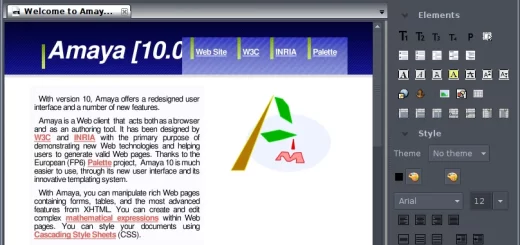World Wide Web advantages, disadvantages, What is the difference between WWW and the Internet?
World Wide Web refers to hypermedia using Hypertext Mark-up Language or HTML, It is known as WWW or W3, When the user would probably places the mouse over the word and clicks the mouse button, the part of the linked document that contains information will be displayed.
World Wide Web
The World Wide Web (Nexus) was invented by Tim Berners-Lee and the first connection was established in 1989, The World Wide Web technology was available for anyone to use on a royalty-free basis in April 1993, The global web of computers known as the internet allows individuals to communicate with each other’s often called the world wide web.
The internet offers a quick and easy exchange of information through the World Wide Web, The World Wide Web is a massive collection of digital pages to access information over the Internet.
WorldWideWeb is the first web browser and web page editor, It was the first WYSIWYG HTML editor, It was later renamed Nexus to avoid confusion between the software and the World Wide Web. The first web browser known as the World Wide Web or WWW or W3, It is a system of internet servers that support specially formatted documents.
WWW is known as Web which is an information space where documents and other resources of the web are identified by the Uniform Resource locators URLs like https://www.example.com which may be interlinked by hypertext and are accessible through the internet. WWW resources are accessed by the users through a software application known as the web browser.
The source code was released into the public domain on 30 April 1993, Some of the code still resides on Tim Berners-Lee’s NeXT Computer in the CERN museum and has not been recovered due to the computer’s status as a historical artifact, To coincide with the 20th anniversary of the research center giving the web to the world, a project began in 2013 at CERN to preserve this original hardware and software associated with the birth of the Web.
WorldWideWeb can display basic style sheets, download and open any file type with a MIME type that is also supported by the NeXT system (PostScript, movies, and sounds), browse newsgroups, and spell checking. In earlier versions, images were displayed in separate windows, until NeXTSTEP’s Text class gained support for Image objects, WorldWideWeb can use different protocols: FTP, HTTP, NNTP, and local files.
The browser is a WYSIWYG editor, It allows the simultaneous editing and linking of many pages in different windows, Files can be edited in a local file system which is, in turn, served onto the Web by an HTTP server. WorldWideWeb’s navigation panel contains Next and Previous buttons that automatically navigate to the next or previous link on the last page visited, similar to Opera‘s Rewind and Fast Forward buttons, or HyperCard.
The World Wide Web uses hypertext over the Internet and the linked documents may be located at different Internet sites, WWW consists of different text formats and different methods of organizing information, It is the main method to access Internet resources, Special index documents have been created in the World Wide Web information space and these can be searched for given keywords.
Advantages of the World Wide Web
The World Wide Web offers the availability of information from anywhere and makes friends from across the globe, The World Wide Web reduces the cost of divulgation, It rapids interactive communication which can be used for different services, It offers a low cost of initial connection, It can facilitate the establishment of professional contact, It facilitates access to different sources of information, which is continuously updated, and it has become the global media.
The World Wide Web is one of the services transferred over these networks, You can learn anything for educational purposes, Anyone can get or collect a lot of free information, World Wide Web facilitates the exchange of huge volumes of data.
World Wide Web offers a rapid interactive communication system with any other which can be used for different services, You will be able to access it from anywhere, the Author completely specifics the representation of the entity, there is no referential ambiguity, and it gives immediate feedback that the user’s action was understood.
The World Wide Web is an internet-based service that uses a common set of rules known as protocols, to distribute documents across the internet in a standard way, You can get details about the definition of the World Wide Web, The World Wide Web is a part of the internet, the web is a view through the web browser software like Google Chrome, Internet Explorer, Mozilla Firefox etc, using browser you can access the digital libraries.
The invention of the World Wide Web made the internet accessible to everyone, It connects people who live in different parts of the world through social networks, websites, blogs, and much more, Many articles, journals, e-books, news, tutorials, stored in the form of web pages on computers around the world called web servers, thousands of web pages or websites are added to the WWW every hour.
Disadvantages of the World Wide Web
There is a danger of overload and excess information, An Efficient information search strategy is required, The search can be slow, It may be difficult to filter and prioritize the information, the Net becomes overloaded because of a large number of users, and there is no quality control over the available data, etc.
What is the difference between WWW and the Internet?
The World Wide Web (WWW) and the Internet are closely related but not the same.
1. Internet:
The Internet includes hardware (servers, routers, fiber optic cables, satellites) and protocols (TCP/IP) that enable connectivity. It is a global network of interconnected computers that allows communication and data transfer. The Internet supports multiple services, such as:
- World Wide Web (WWW)
- Email (SMTP, IMAP, POP3)
- File Sharing (FTP, P2P)
- Streaming & VoIP (YouTube, Zoom, Skype)
2. World Wide Web (WWW):
The WWW is a service that runs on the Internet and consists of websites and webpages accessed via web browsers. It uses HTTP/HTTPS protocols to display hyperlinked documents (HTML pages). It was invented by Tim Berners-Lee in 1989 and is just one part of the Internet.
The Internet is like a highway system, and the WWW is like cars traveling on that highway. You can use the highway for other purposes too (like sending letters or making phone calls), just like the Internet supports more than just the Web.
What are the advantages and disadvantages of using the Internet?
Benefits & application of Artificial intelligence in business, E-commerce, and marketing
Intranet advantages, disadvantages, How do Intranet, Internet and Extranet differ?
What are the advantages and disadvantages of Internet banking?




